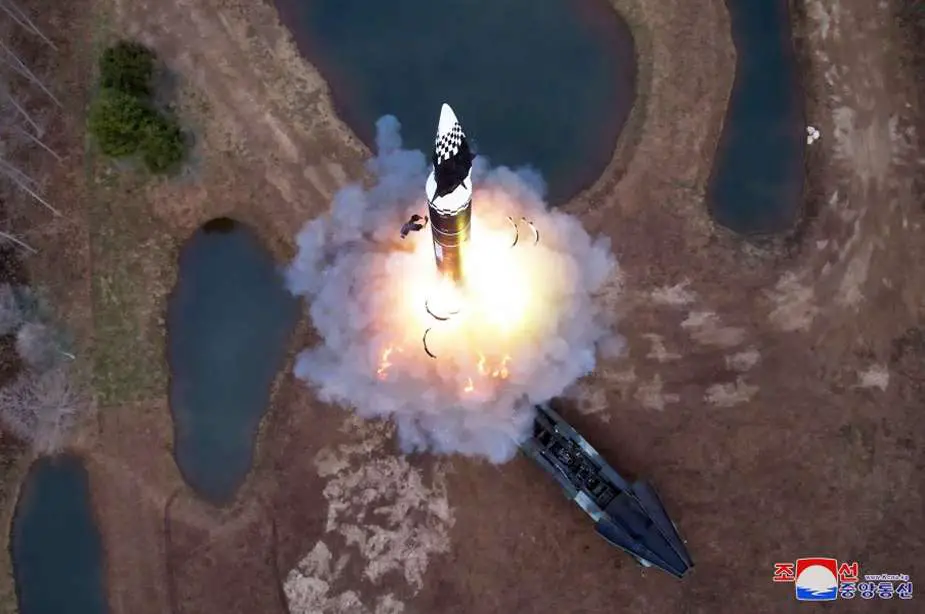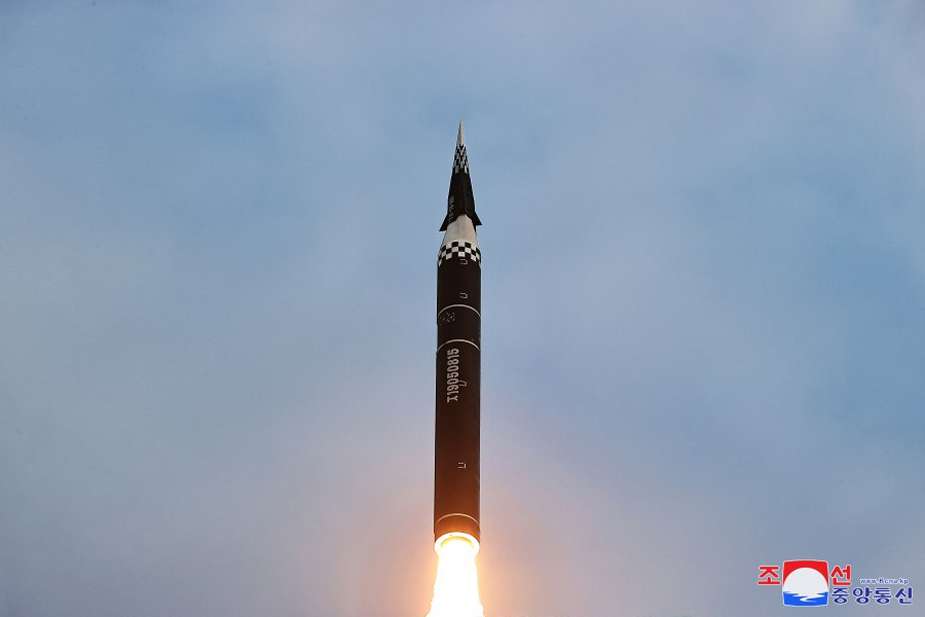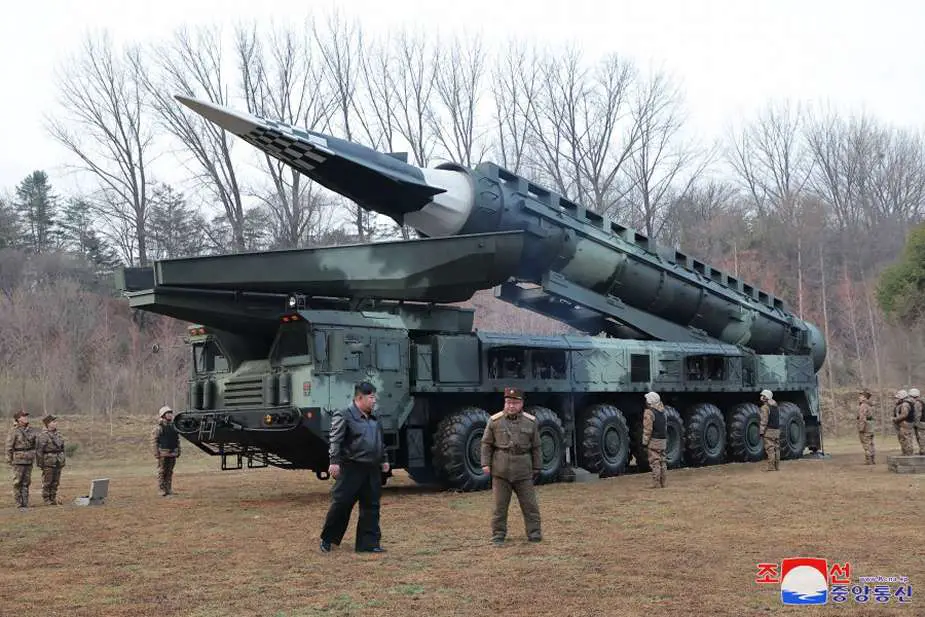On April 3, 2024, North Korea announced the testing of a new missile, referred to as the Hwasongpo-16na or Hwasong-16B, depending on the source. The test, conducted on April 2, showcased a hypersonic intermediate-range ballistic missile (IRBM) equipped with a newly developed hypersonic glide vehicle (HGV), and powered by solid fuel, marking a departure from the liquid-fuel engines previously used in the country's hypersonic ballistic missiles.
Follow Army Recognition on Google News at this link

The new missile, referred to as the Hwasongpo-16na or Hwasong-16B, is equipped with a newly developed hypersonic glide vehicle (HGV), which could improve the survivability of North Korea's nuclear missile arsenal. (Picture source: KCNA)
The Rodong Sinmun, a North Korean state media outlet, detailed the Hwasongpo-16na missile as being equipped with a newly developed hypersonic glide vehicle (HGV), which could improve the survivability of North Korea's nuclear missile arsenal. The missile was displayed on a 14-wheel transport-erector-launcher (TEL), with a clamshell section to protect the HGV until deployment. North Korean leader Kim Jong Un underscored this development as a significant step toward ensuring that North Korea’s missile forces can conduct nuclear strikes swiftly, precisely, and powerfully.
Hypersonic glide vehicles (HGVs) are a type of warhead mounted on ballistic missiles to glide and maneuver at hypersonic speeds, defined as speeds greater than Mach 5. These vehicles can significantly alter their trajectory post-launch, thereby limiting the risk of interception by an adversary's air defense systems. The operational principle of HGVs, which can carry both conventional and nuclear payloads, shares similarities with MaRVs (maneuverable reentry vehicles), but there is a notable difference in their behavior. HGVs detach from their rocket boosters shortly after launch, whereas MaRVs are capable of maneuvering only during the final stages before impact.
Launched from a site in eastern Pyongyang, previously used for similar tests, the Hwasongpo-16na relied on a solid-fuel engine, which offers advantages over liquid-fuel missiles, including enhanced safety and maintenance, and reduces the preparation time for launch, diminishing the window for preemptive strikes.
According to North Korean state media, the test's objective was to verify the missile system's technical specifications and reliability, particularly focusing on the hypersonic glide vehicle's performance. During this test, they said the Hwasongpo-16B's hypersonic glide vehicle demonstrated advanced maneuverability, capable of executing "gliding-skip" trajectories. Such capabilities challenge missile defense due to the vehicle’s speed, maneuverability, and unpredictable flight path. North Korean authorities have also highlighted the missile's "military strategic value," implying its potential for both conventional and nuclear payloads, though specifics were not disclosed.

The new North Korean missile is powered by solid fuel, marking a departure from the liquid-fuel engines previously used in the country's hypersonic ballistic missiles. (Picture source: KCNA)
North Korea reported that this test marks the completion of the country's project to transition its missile systems to solid-fueled engines equipped with nuclear warheads and precision control capabilities. Kim Jong-un highlighted the Hwasongpo-16na/Hwasong-16B missile as an example of the nation's defense technology prowess, pointing to future enhancements in missile systems, including the utilization of solid fuel, warhead control, and nuclear capabilities, in line with strategic objectives.
According to state reports, the missile reached peak altitudes of 101.1 kilometers and then 72.3 kilometers, completing a 1,000-km flight as planned, and accurately impacting a target area in the East Sea of Korea, also known as the Sea of Japan. However, the claims made by North Korea were contested by South Korea and Japan, with the South Korean Joint Chiefs of Staff and Japan's Defense Ministry reporting shorter flight distances and questioning the accuracy of North Korea's claims. According to the South Korean military, the missile flew approximately 600 kilometers before landing in the East Sea, categorizing it as an intermediate-range ballistic missile.
This test arrives amidst North Korea's perceptions of heightened military threats, possibly in reference to military exercises by the United States and South Korea, which Pyongyang views as provocations. Since the start of 2024, South Korea and the United States have jointly conducted several live-fire exercises near the North Korean border. North Korea's state media criticized these exercises as provocative, raising concerns about heightened tensions and potential clashes. In response, South Korea has intensified monitoring of North Korean military activities, notably observing over 90 artillery firings on January 7, 2024. Additionally, to bolster surveillance capabilities, the South Korean Defense Acquisition Program Administration (DAPA) announced plans on January 8, 2024, to deploy two additional military spy satellites equipped with synthetic aperture radar (SAR) technology, scheduled for launches in April and November 2024.
In response, Kim Jong-un has noted the importance of developing capabilities to counter these perceived confrontational military acts and exercises by adversaries. This test, which represents the third ballistic missile test conducted by North Korea within the year, follows an increased pattern of North Korean military activities, including arms deliveries to Russia and Hamas, several massive artillery drills near the South Korean border, as well as advancements in its military capabilities. These new capabilities include the test of the Hwasal-2 strategic cruise missile, launches of the new Pulhwasal-3-31 submarine-launched strategic cruise missile, the unveiling of the new M2024 Main Battle Tank, and tests of newly developed 240mm and 600mm multiple rocket launcher systems (MLRS).
The situation has been further exacerbated by a series of recent statements and actions from North Korea, including a speech made by Kim Jong-un on December 31, 2023, threatening a nuclear attack on Seoul and ordering an expansion of the country's military capabilities in anticipation of potential conflict on the Korean Peninsula. North Korea's strategy, as interpreted from these actions, seems to involve escalating tensions to possibly extract concessions, particularly considering potential political changes in the United States.

The missile was displayed on a 14-wheel transport-erector-launcher (TEL), with a clamshell section to protect the HGV until deployment. (Picture source: KCNA)
















